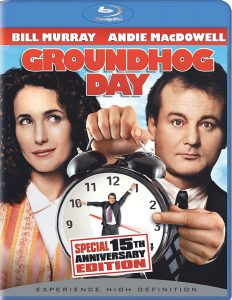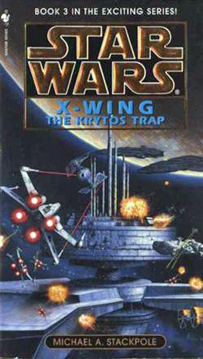Always one to look for a new challenge, Michael Stackpole follows up a novel about pilot culture (“Rogue Squadron”) and a novel about undercover work (“Wedge’s Gamble”) with a novel featuring courtroom drama and a prison break — the third “X-Wing” book, “The Krytos Trap”(1996).
If the first book had elements of “Top Gun” and the second had elements of “Mission: Impossible,” this third entry mixes “Perry Mason” with “The Shawshank Redemption.” However, a reader is never overly aware of the homages because Stackpole keeps plot and characters front and center. In terms of crafting an in-depth yet clear plot, I’d rank him No. 1 among “Star Wars” authors.
By the end of “The Krytos Trap,” Stackpole has earned the scene where Luke Skywalker congratulates Rogue Squadron on their successes. This is a necessary sequence — it makes sense that THE hero of the Rebellion would congratulate the newest batch of heroes — and it “officially” brings the Rogues up to the level of the major characters. In another sense, it almost feels like Luke — as a “star” character — is intruding in the spotlight of the “X-Wing” characters, our favorite unsung heroes. By this point, I don’t need the hook of a movie character to be engrossed by these stories.
Stackpole, in continuing the theme of not repeating himself, ends “The Krytos Trap” with a surprising set-up for book four, “The Bacta War,” wherein the Rogues will go rogue, pursuing a mission against the wishes of the New Republic — doing what they think is the right thing over what is technically legal.
“The Krytos Trap” itself touches on challenging political ideas. Tycho Celchu has been treated horribly by the very government he has risked his life for — the New Republic puts him on trial for Corran Horn’s murder at the end of “Wedge’s Gamble” — yet he calmly insists that it’s still much better than living under the Empire. Meanwhile, a reader knows a scene of Corran dramatically bursting into the courtroom is forthcoming, and it’s worth the wait. As a fascinating parallel, Corran is himself in the clutches of Ysanne Isard’s Lusankya prison, the same one that tried to program Tycho into betraying the Republic.
Indeed, a third character proves susceptible to the brainwashing where Tycho and Corran were too strong for it. The idea of a person being programmed to behave a certain way had also started to be explored in “The Clone Wars,” which had delved a bit into the exact nature of Order 66 before it was canceled. Torture and imprisonment were also a central themes of Matthew Stover’s “New Jedi Order: Traitor,” a challenging but ultimately rewarding read.
“The Krytos Trap” is a little easier to stomach, partly because Stackpole once again proves himself to be a student of “Star Wars” lore beyond his own work. Smoothing over what had been a plot hole in the wider narrative, he introduces a character named Jan at the prison, thus explaining how Rebellion General Jan Dodonna was “killed” in Archie Goodwin’s newspaper strips yet is alive in “Dark Empire.” Although the official revelation of the character’s identity and his return to military service doesn’t happen here, I bet many savvy readers figured it out on the first read.

Although it doesn’t add anything new to the courtroom or prison genres, “The Krytos Trap” handles both with near-perfection and continues to give us page-turning plots and characters we care about. After the last page, you’ll say “Bring on ‘The Bacta War.’ “

